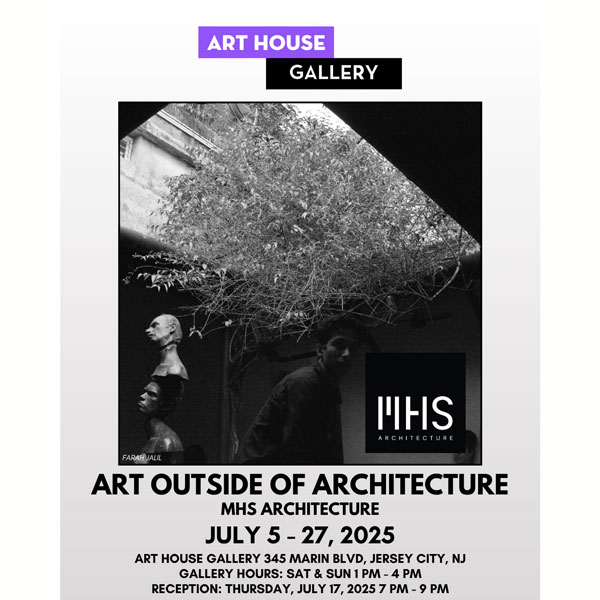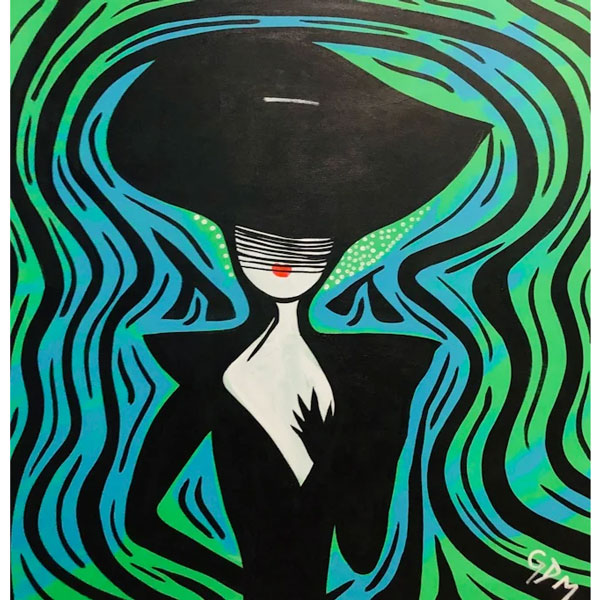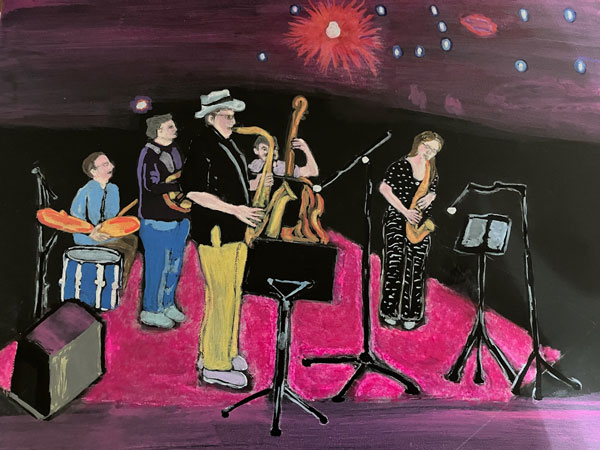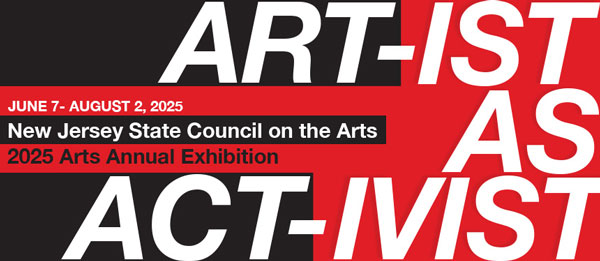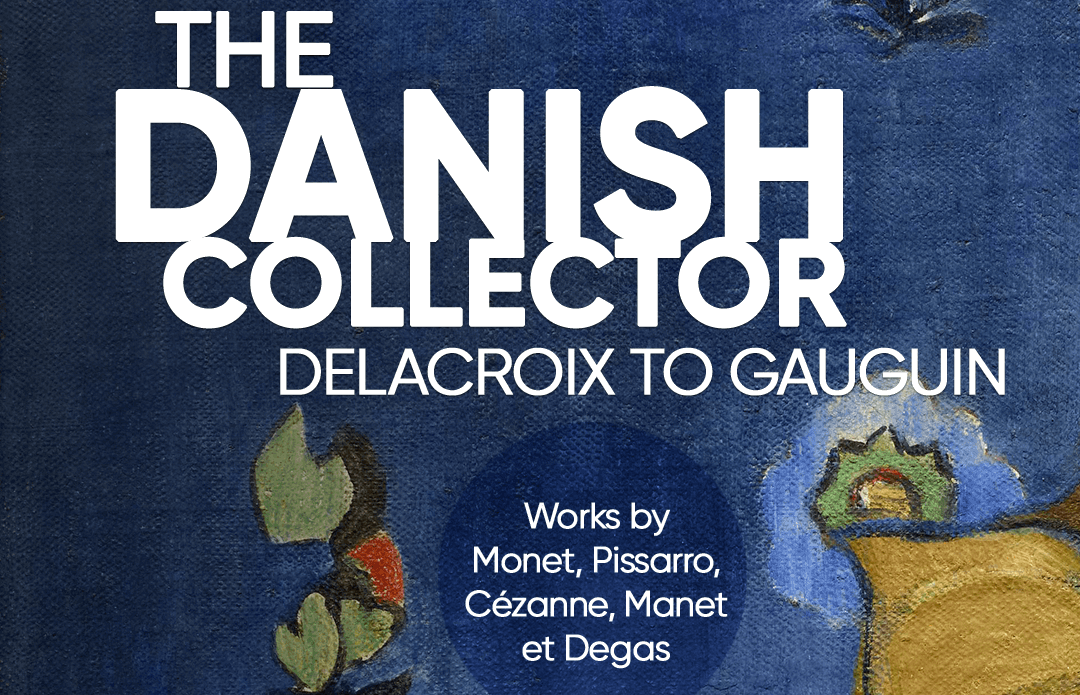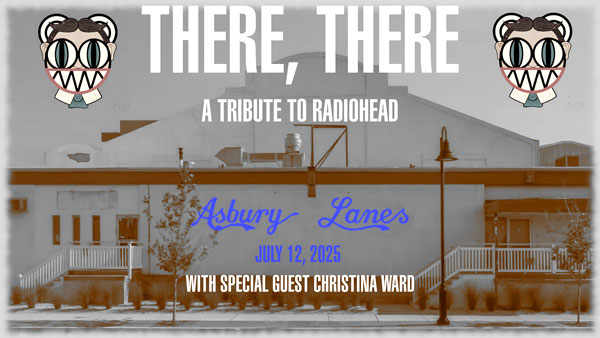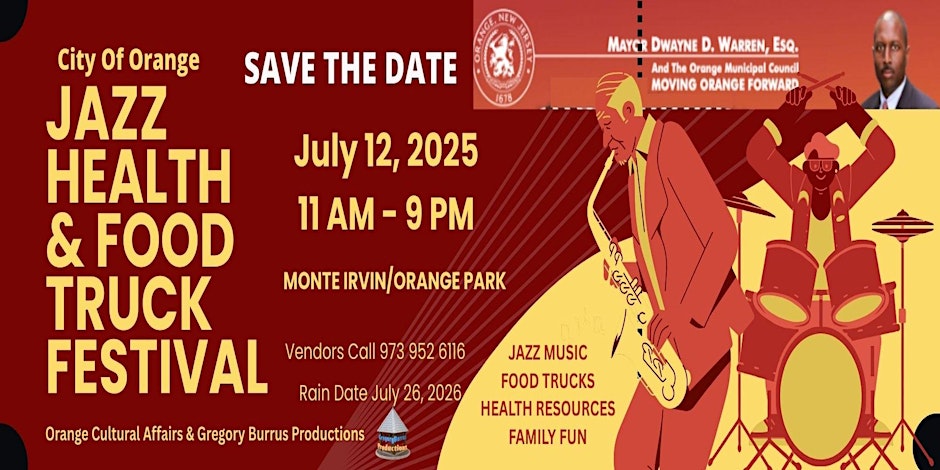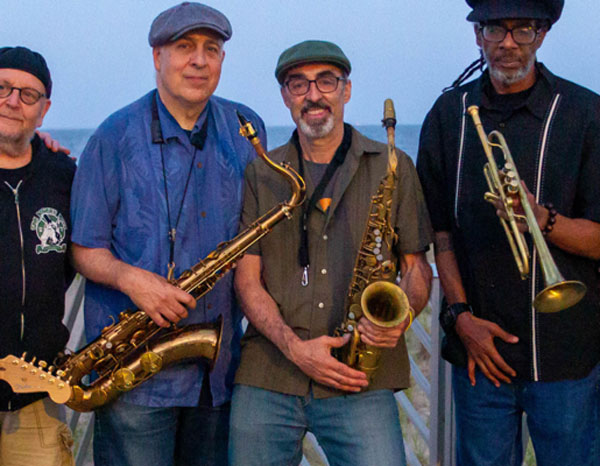By Ilene Dube, JerseyArts.com
originally published: 09/29/2022

Photo: Wendell T. Brooks, “Homage to Jesse Owens,” c. 1980, color intaglio, 22.5x24.75” (photo courtesy of Mary Guess Flamer); Hughie Lee-Smith, “Duet,” 1987, oil on canvas, 24x18” (photo courtesy of Anita Blanchard); Rex Goreleigh,” Spring Pruning,” 1966, oil on canvas, 66x42” (photo courtesy of Malcolm Peyton and Barbara Winchester); James Wilson Edwards, “African Sky,” 1985, oil on canvas, 24x30” (photo courtesy of Lewis Tanner More)
A selection of Black artists from the Greater Princeton Area, long overlooked, is finally getting its due thanks to a group of collectors who recognized and preserved the body of work and two ambitious curators.
Retrieving the Life and Art of James Wilson Edwards and a Circle of Black Artists, on view at the Arts Council of Princeton Oct. 14 – Dec. 3, is celebrating the intertwined lives and stories of James Wilson Edwards, Rex Goreleigh, Hughie Lee-Smith, Selma Hortense Burke, and Wendell T. Brooks. The exhibition kicks off with a panel discussion, “Art Collecting as an Act of Love,” Oct. 14 from 4-5 p.m., featuring the lenders to the exhibition and moderated by curators Judith K. Brodsky and Rhinold Ponder.
The idea for the exhibition came about when collector Lewis Tanner Moore approached the Arts Council about showing the works of James Wilson Edwards (1925-1991), of which Moore has a significant holding.
Moore is the great grand-nephew of Henry Ossawa Tanner (1859-1937), a major American artist who studied at the Pennsylvania Academy of the Fine Arts (PAFA) with Thomas Eakins. Tanner was the first African American artist to gain international acclaim.
As an art history student at the Chestnut Hill Academy in 1969, Moore became aware that the classic H.W. Janson textbook set its focus on white European male artists. “It included no people like me, no women, no Asian or brown people. In its aim to convey a complete history of the world, it fails to portray the full picture,” he says by phone from his Bucks County, Pennsylvania, farmhouse, where he is surrounded by his collection. Looking at the Janson text he wondered: where were the works of Romare Bearden, Jacob Lawrence and Selma Burke?
“In Search of Missing Masters: the Lewis Tanner Moore collection of African American Art,” a catalog and exhibition at the Woodmere Museum of Art in 2008, was among his efforts to set the record straight.
As a boy, Moore collected bottlecaps and feathers. At age 17 he moved into collecting art with “a little carved folk art figure, but I hadn’t yet figured out what I wanted to collect,” says Moore. A book on the shelves in his family home, “The Negro in Art” by Alaine Locke, focusing on Black artists and African American art, guided Moore’s collecting. Along with inherited family holdings, his collection took off. “It began a pattern of seeing things that spoke to me.”
Moore describes collecting as “a condition or a reflex. Some people are drawn to gather and sort,” he says. “Writers write to know what they think, collectors collect to see what they value and to give order to that. In my case it goes beyond sheer pleasure, as I’m trying to correct the ledger that has been improperly recorded.”
Today he owns works by such major Black artists as Romare Bearden, Jacob Lawrence, Sam Gilliam, Faith Ringgold, Elizabeth Catlett, Paul Keene and Barkley Hendricks.
Moore’s father had been the founder of the Pyramid Club (1937-1963), a social organization for professional African Americans in Philadelphia that provided a gathering place when people of color could not visit restaurants as fluidly as white people. The club offered an arts program and exhibitions.
The circle the Moore family engaged with included artist Paul Keene (1920-2009). “I got to see his studio when I was a teenager,” recollects Moore. “I saw his process close-up. We maintained a close friendship, he was one of those steady voices, an inspiring artist.”
Moore says his father was not a collector, but “had a reasonable amount of art. He was in the right place and time and ended up with wonderful things but not as many as I would have liked.”
Having earned a master’s degree in human service administration, Moore spent his working years at the Philadelphia Department of Health. He was able to fund his collection by making smart choices, he says. He was acquiring art when the works were undervalued. “I spent my disposable income on what mattered to me,” forgoing choices others might make in, say, expensive cars.
"Some people collect art as an investment or to acquire social cachet, others because they become enchanted with a particular artist or movement,” wrote the late critic Ed Sozanski in the Philadelphia Inquirer in 2008. “But Moore collects because he wants the public to become aware of creativity that was ignored or suppressed."
Moore cites James Edwards as the perfect example of such an artist. “I came across a small painting of his in Lambertville and was immediately drawn. It was a poignant scene of a woman in front of trees. I thought someone who does work of that quality should be better known.” Moore contacted Edwards’ widow and learned that Edwards had been friendly with artists Rex Goreleigh, Hughie Lee-Smith and Selma Burke. The latter two were also friends of Moore. Goreleigh, Lee-Smith, and Burke all got their start with the Works Progress Administration/Federal Art Project created during the Great Depression to provide employment for artists. The program was a vehicle for women artists and artists of color to enter the mainstream. Moore felt Edwards deserved the same recognition as the other three.
Selma Burke, Untitled (bust), n.d. plaster with bronze patina, approximately 30x32x10” (photo courtesy of Lewis Tanner Moore)
Edwards’ work is “lyrical and poetic,” says Moore. “It has a range of technique that he brings to canvas. I was most drawn to his ethereal painting of a woman dancing on the edge of a rooftop, looking elegant. He has great command of his craft and does everything from loose landscapes to trompe l’oeil.”
Motivated in part by an article in Ebony Magazine about Glen Acres, an interracial housing development in West Windsor at the edge of Princeton, Edwards moved to Princeton, purchasing a house at 110 Cherry Valley Road in 1959 to raise his young family in an accepting environment. His wife, Verena, originally from Switzerland, is white. Edwards lived in Princeton until his death in 1991, actively teaching and participating in exhibitions. “He would almost have disappeared from history except for interest in his work on the part of Lewis Tanner Moore,” says curator Judith Brodsky, an artist, author, noted scholar of feminist art, and Distinguished Professor Emerita, Department of Visual Arts, Rutgers University. Brodsky, who was also the founder of the Brodsky Center for Innovative Print and Papermaking, had known Moore before working together on the exhibition. Moore was active at PAFA, where the Brodsky Center is located.
“Although primarily a figurative painter, Edwards experimented with various forms of abstraction and explored sculpture and printmaking,” says Brodsky, speaking from the patio surrounded by lush hydrangeas at her Princeton home. “He investigated the female face and figure from a Black perspective. An avid reader of art history and world culture – he had a big library – Edwards was really interested in the female form. His nude studies and portraits of imaginary women show various influences ranging from Northern Renaissance painters like Jan van Eyck to African sculpture.”
Orphaned as a child, Edwards served in the Marines and studied art at the Art Students League in New York and, under the G.I. Bill, at Academie Julian in Paris, a city known for being more welcoming to Black artists and writers. (Goreleigh, Lee-Smith, and Burke all spent time in Paris, as did Henry Ossawa Tanner.) From Paris, Edwards created spot illustrations for the New York Herald Tribune and, when he returned to the U.S., was assistant to a professor in the School of the Arts at Madison University.
In Princeton, Edwards taught at Rex Goreleigh’s Studio on the Canal. In 1964, Edwards and Goreleigh formed a graphic design firm. While a drafting specialist for Princeton Plasma Physics Laboratory, Edwards won a contest to design a logo for Princeton’s Firestone Library. All the while, he was exhibiting his work in area galleries as well as at Mercer County Community College, The College of New Jersey, and the New Jersey State Museum.
While working together, Brodsky, who is white, and co-curator Rhinold Ponder – an artist, activist, writer, lawyer and founder of Art Against Racism, who is Black – had lively conversations about the beauty standards of different cultures. They hadn’t know each other before working together on the exhibition, but when the pandemic set the project back two years, Brodsky and Ponder teamed up to work on a virtual exhibition for Art Against Racism.
“I love working with Judy – she just keeps going and creating where other people would stop,” says Ponder, referring to Brodsky’s perseverance in tracking down Edwards’ family so they could present a clear picture of his life. Brodsky says the exhibition, with its accompanying catalog and video, benefited from the extra two years of research.
A one-time professor of African American studies and law at City University of New York and professor of constitutional law and African American Studies and literature at Rutgers, Ponder is largely focused on making art these days. A recent exhibition of his work at the Arts Council of Princeton included several emotionally charged paintings about lynching. He was especially drawn to Rex Goreleigh’s painting on that topic, “Spring Pruning,” included in this exhibition.
“When I first looked at it, it took a while to pick up on its subtleties. You see dead trees, no leaves, with ropes hanging. What’s being pruned?” he asks. In the foreground is the back of a strong-looking Black man holding an ax. Looking ahead at the bare trees and nooses, he appears poised to defend. “Lynching was a big issue the NAACP and others were taking on at the time of the painting (1966). It’s obvious from his paintings that Goreleigh was a very political being. Here he is telling a story: how much strength it takes to attack the problem.”
Additional lenders to the exhibition include Dr. Anita Blanchard, Mary Guess Flamer, Lawrence Hilton, Brenda and Lawrence Thompson, Joye and Scott Shepperd, Malcom Peyton and Barbara Winchester, and James Petrucci.
RELATED PROGRAMS
Panel: Art Collecting as an Act of Love, Resistance and Preservation of History
Friday, Oct. 14, 2022 | 4-5 p.m.
Free and open to the public
Opening Reception
Friday, Oct.14, 2022 | 5-7 p.m.
Free and open to the public
Symposium: How Museums Are Diversifying Their Collections to Include Black and Brown Artists
Thursday, Nov. 3, 2022 | 5-7 p.m.
Free and open to the public
Presentation: Roots & Branches of the 20th Century Black Arts Movement: Paul, Ossie, and Alvin with Dr. Joy Barnes, Educator in Science and Racial Literacy
Saturday, Nov. 19, 2022 | 1-2 p.m.
Free and open to the public
Panel: Restoring the Overlooked History of Black Artists in Princeton and Trenton in the Later 20th Century Through Local Research, Preservation, and Oral History
Wednesday, Nov.30, 2022 | 4-6 p.m.
Free and open to the public
About the author: Driven by her love of the arts, and how it can make us better human beings, Ilene Dube has written for JerseyArts, Hyperallergic, WHYY Philadelphia, Sculpture Magazine, Princeton Magazine, U.S. 1, Huffington Post, the Princeton Packet, and many others. She has produced short documentaries on the arts of central New Jersey, as well as segments for State of the Arts, and has curated exhibitions at the Trenton City Museum at Ellarslie and Morven Museum in Princeton, among others. Her own artwork has garnered awards in regional exhibitions and her short stories have appeared in dozens of literary journals. A life-long practitioner of plant-based eating, she can be found stocking up on fresh veggies at the West Windsor Farmers Market.
Content provided by
Discover Jersey Arts, a project of the ArtPride New Jersey Foundation and New Jersey State Council on the Arts.
EVENT PREVIEWS



